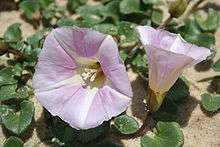Calystegia soldanella
| Calystegia soldanella | |
|---|---|
 | |
| Scientific classification | |
| Kingdom: | Plantae |
| (unranked): | Angiosperms |
| (unranked): | Eudicots |
| (unranked): | Asterids |
| Order: | Solanales |
| Family: | Convolvulaceae |
| Genus: | Calystegia |
| Species: | C. soldanella |
| Binomial name | |
| Calystegia soldanella (L.) R.Br. ex Roem. & Schult. | |
The morning glory Calystegia soldanella (syn. Convolvulus soldanella) is a species of bindweed known by various common names such as seashore false bindweed, shore bindweed, shore convolvulus and beach morning glory. It is a perennial vine which grows in beach sand and other coastal habitats in temperate regions across the world.[1] It is also known as 'The Prince's Flower' after Prince Charles Edward Stuart who sowed it on the Island of Eriskay,Scotland, when he landed there in 1745 to lead the Jacobite rising.[E. Dwelly Gaelic Dictionary (1911)]
The plant bears fleshy stems, kidney-shaped leaves, and attractive morning glory flowers with corollas delicate pink to vivid lavender. They are insect-pollinated.
Distribution
In North America Calystegia soldanella is found on the west coast and selected areas of the east coast. In the United Kingdom it is widespread on the sandy coasts of England and Wales, less common in Scotland and Northern Ireland. It is also widespread around the coast of Ireland[2]
References
- ↑ "Calystegia soldanella". New Zealand Plant Conservation Network. Retrieved 12 August 2012.
- ↑ "Online Atlas of British and Irish Flora".
- USDA Plants Profile
- Jepson Manual Treatment
- Munz, Philip A. (2003). Introduction to Shore Wildflowers of California, Oregon, and Washington. Berkeley: University of California Press.